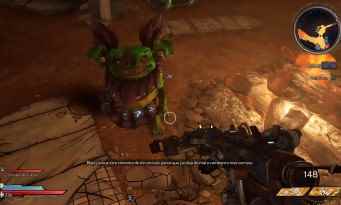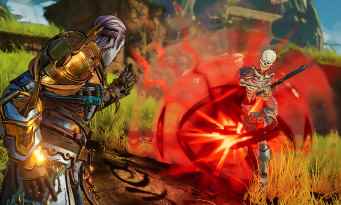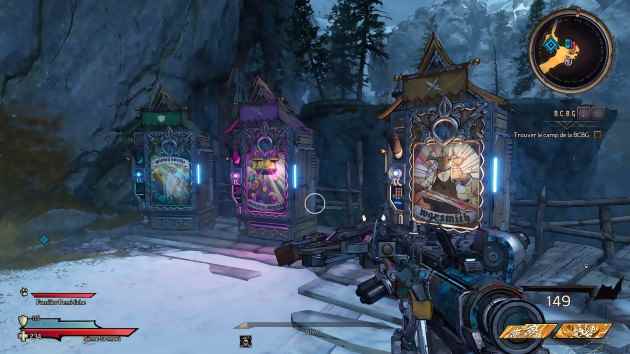We were able to get our hands on a partial, but representative, version of this future game. Of the six classes in the final version, two were already available for testing. And if the main quest was still forbidden to us, we were still able to complete several secondary quests in a large open area. Enough to take our character from level 9 to level 13 in a few hours. We first tried the Sowing Death class for a few tens of minutes, which can sacrifice part of its health to inflict additional which features a demilich familiar that deals dark magic damage to enemies. But our choice finally stopped on the Trucidopath, capable of throwing a spinning phantom sword at his opponents, and whose chance of critical hits is increased by 30% by base. While each character type has a skill tree relating to their special abilities, all share the same hero stat system. Thus, Strength, Dexterity, Intelligence, Wisdom, Constitution and Attunement act respectively on critical damage, critical hit chance, spell recharge, elemental damage, maximum shield/health level, and skill recharge. Under these conditions, increasing the Strength of the Trucidopath to the maximum seems self-evident. And we can already confirm that it is possible to build a real brute, capable of inflicting an extremely high number of damage per second!
FROM D&D TO B&B, AND FROM MJ TO MB
 If these statistics smack of medieval-fantasy role-playing games, that’s completely normal. Just like Tiny Tina and the Dragon Fortress in the past, Tiny Tina’s Wonderlands swaps the futuristic world of Borderlands for a game of Bunkers & Brutasses, a tabletop role-playing game obviously parodying the famous Dungeons & Dragons. Still as geeky as ever, Tina plays the role of Bunker Master and therefore organizes the game. As a player, we therefore embody a character from Bunkers & Brutasses himself embodied by a character from Borderlands. This “meta” context gives role-playing participants the opportunity to regularly break the fourth wall by commenting on the action in progress. A medallion with their portrait then appears at the top right of the screen, which allowed us to see that a man named Valentine and a robot named Frette were in the “real” world. Whether it’s Tina explaining to players that they’ve suddenly come across “a huge, hyper-magical contraption” or Valentine offering to drop the current quest at the first obstacle encountered, the remarks of these real-fake players are generally humorous. These interventions also highlight a French version with small onions. Not only do the voices ring true, but the translators have done a real localization job by adapting the cultural references. Thus during a quest to trigger a revolution in a goblin mine, you will have the opportunity to hear Valentine humming and twisting the words of the song “My revolution” by Jenifer. We can easily imagine that in VO, it’s a completely different song that is used.
If these statistics smack of medieval-fantasy role-playing games, that’s completely normal. Just like Tiny Tina and the Dragon Fortress in the past, Tiny Tina’s Wonderlands swaps the futuristic world of Borderlands for a game of Bunkers & Brutasses, a tabletop role-playing game obviously parodying the famous Dungeons & Dragons. Still as geeky as ever, Tina plays the role of Bunker Master and therefore organizes the game. As a player, we therefore embody a character from Bunkers & Brutasses himself embodied by a character from Borderlands. This “meta” context gives role-playing participants the opportunity to regularly break the fourth wall by commenting on the action in progress. A medallion with their portrait then appears at the top right of the screen, which allowed us to see that a man named Valentine and a robot named Frette were in the “real” world. Whether it’s Tina explaining to players that they’ve suddenly come across “a huge, hyper-magical contraption” or Valentine offering to drop the current quest at the first obstacle encountered, the remarks of these real-fake players are generally humorous. These interventions also highlight a French version with small onions. Not only do the voices ring true, but the translators have done a real localization job by adapting the cultural references. Thus during a quest to trigger a revolution in a goblin mine, you will have the opportunity to hear Valentine humming and twisting the words of the song “My revolution” by Jenifer. We can easily imagine that in VO, it’s a completely different song that is used.
MEDIEVAL AND FANTASTIC BORDERLANDS?
 Based on very solid fundamentals, because inherited from Borderlands 3, Tiny Tina’s Wonderlands incorporates everything that makes the charm of the series: loot everywhere all the time, numerous quests, multiple chests to open, weapons available endlessly, heaps of enemies to slay, good big bosses, and humor, always humor. One of the secondary quests is thus addressed to us by Bench, a goblin in search of a “specialist in non-violent de-escalation” (we would really need it IRL by the way…). You must first meet the sorcerer Baadaar le badant, whom you can choose to seduce instead of slaying. There follows a short chase around his home, the guy not really being sensitive to our advances. Further, it is a goblin guard that can be distracted, bribed, or hit on. We advise you to choose this last option again, which is particularly profitable here. The guard then falls in love with our character, as indicated by the small hearts floating above his head. This allows us to enjoy tasty dialogues as well as a temporary ally, ready to fight alongside us.
Based on very solid fundamentals, because inherited from Borderlands 3, Tiny Tina’s Wonderlands incorporates everything that makes the charm of the series: loot everywhere all the time, numerous quests, multiple chests to open, weapons available endlessly, heaps of enemies to slay, good big bosses, and humor, always humor. One of the secondary quests is thus addressed to us by Bench, a goblin in search of a “specialist in non-violent de-escalation” (we would really need it IRL by the way…). You must first meet the sorcerer Baadaar le badant, whom you can choose to seduce instead of slaying. There follows a short chase around his home, the guy not really being sensitive to our advances. Further, it is a goblin guard that can be distracted, bribed, or hit on. We advise you to choose this last option again, which is particularly profitable here. The guard then falls in love with our character, as indicated by the small hearts floating above his head. This allows us to enjoy tasty dialogues as well as a temporary ally, ready to fight alongside us.
Beyond the touches of humor, the medieval-fantasy atmosphere of Bunkers & Brutasses offers a pleasant variation of the Borderlands universe. The “Second Wind” mechanic, which allows you to come back to life under certain conditions, is called here “Saving Throw”. The distributors of weapons, armor and spells are made of wood. The essential Claptrap is also entirely made of wood, with the notable exception of a small twisted and metallic chimney enthroned on its head. The enemies we face are no longer robots, humans and space creatures, but trolls, wyverns, skeletons, hammerhead sharks and other fish-dogs. And some collectibles take the form of 20-sided dice. The interface also tells us that there are 260 to find around the world. Knowing that the large area that we were able to visit contained only 19 of them, Tiny Tina’s Wonderlands seems well on its way to offering us a strong lifespan. far superior to that of Tiny Tina and the Dragon Fortress, which was completed in five to ten hours.



